How To Keep Romaine Lettuce Fresh: Make It Easy To Eat More Salad
Sneak Peek: Learn how to keep romaine lettuce fresh by vacuum-sealing it into jars 7-10 days in advance. If you’ve ever wondered if you could cut up lettuce ahead of time but somehow keep the edges from turning brown and going bad, the answer is “YES.” This easy technique transformed me into a DAILY salad eater.
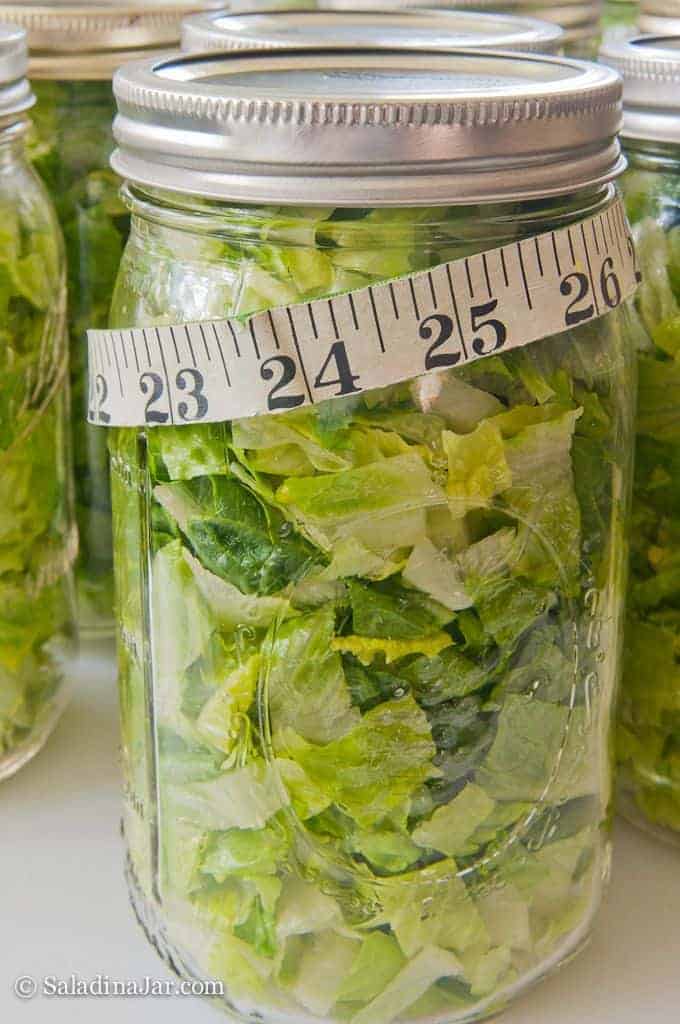
As an Amazon Associate, I earn from qualifying purchases.
Do you wish you were eating more lettuce salads? I used to feel the same way. Now I’m a DAILY salad eater, and you can be, too!
With this unique trick, you can enjoy a daily salad as fast as you can take the lid off. I call it healthy fast food. It’s nearly as easy as opening a bag of chips.
Seven Benefits of Vacuum-Sealing Lettuce To Keep It Fresh
1. Prepare 7-10 jars of ready-to-eat romaine lettuce in 30-45 minutes.
These numbers may vary depending on the freshness of your lettuce and how fast you work. Of course, it may take longer in the beginning. Doesn’t every new recipe or skill take longer at first?
2. Keep chopped lettuce from turning brown.
The vacuum-sealing process removes all the oxygen from inside the jar. So even though the leaves are chopped with a knife, the cut leaves are prevented from oxidizing.
3. You don’t have to get out your chopping board and salad spinner daily to make a salad.
Call me lazy, but when I’m famished, I don’t like to take the time to clean, dry, and cut or tear lettuce. So, having prepared jars of lettuce salad in the fridge has saved me from eating a lot of junk food.
4. On the run? Grab a jar and take it with you.
You can eat your salad straight out of the jar. But it’s easier to pour it into a bowl. My lunch bag is big enough to fit a salad bowl if I’m taking my lunch with me.
5. Save money–especially when you buy romaine lettuce in bulk.
Bulk warehouses like Costco or Sam’s are the cheapest place to buy romaine. You can purchase the heads in packages of six.
I’m fond of the artisan romaine sold at Costco. They are slightly more expensive but worth it.
6. This habit encourages healthier eating habits.
No guarantees on this one. If you eat a healthy salad daily, it could be the start of a new lifestyle. I eat about 7-8 cups of lettuce salad almost every day. Works for me.
7. Customize your salad according to what’s in the fridge and your current mood.
Add your dressing and any veggies, nuts, or other extras after you open the jar and pour it into a bowl. Try adding fruits like sliced apples, orange sections, and pomegranate seeds, to name a few. Leftover meat, canned salmon or tuna, nuts, seeds, fresh veggies, or avocado are just a few of the ingredients I keep around to make a salad of the day in less than 3 minutes.

Happy Cooks Speak Up
“I love your recipes and continue the habit of sealing lettuce every week-we are on our 2nd sealer now. LOL Makes my life so easy for salads daily for my work lunch and our dinners too. My husband and I talk about how we would be so tempted to skip salads and make not-so-healthy choices if those jars weren’t in our fridge ready to go.” —ELLEN E.
“I am a Happy camper!!!!! I put up 6 mason jars of lettuce and I added a bit of red cabbage. The best salad EVER!!!!!! The romaine was so crispy. Thanks for the idea. It is a breeze to just dump the jar of prewashed salad on a plate ,,,,,,, add a tomato and an egg. Quick meal.”–MICHAELLE K.
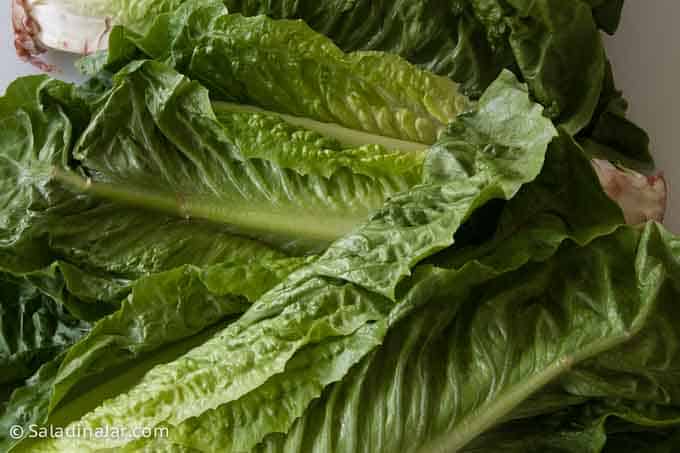
How Do You Make Romaine Lettuce Last Longer in the Refrigerator?
This “salad in a jar” is not the traditional layered salad everybody else makes. It’s also not “canned lettuce,” although it may look like it. The lettuce is not heat-processed.
Instead, this fresh, cleaned, and chopped lettuce has been vacuum-sealed into a Mason jar and stored in the fridge so it won’t wilt. The process is not complicated or expensive!!
Can You Vacuum-Seal Lettuce?
Yes. When vacuum-sealed into a glass Mason jar, chopped romaine lettuce will stay crisp and fresh for 7-10 days. Store lettuce in the refrigerator.
To be clear: We’re assuming the lettuce is fresh. So don’t pack lettuce that has been hanging around in some warehouse or your fridge for too long.
Old and wilted lettuce will shorten the freshness window for a vacuum-sealed jar of salad.
Are There Other Ways To Save Lettuce in Jars?
1. Can I freeze these jars of lettuce?
No. The lettuce will wilt and spoil when you remove it from the freezer.
2. Are these jars heat-packed or pressure-cooked?
No. Lettuce is much too delicate for that kind of treatment.

How To Prepare Romaine Lettuce for Vacuum-Sealing
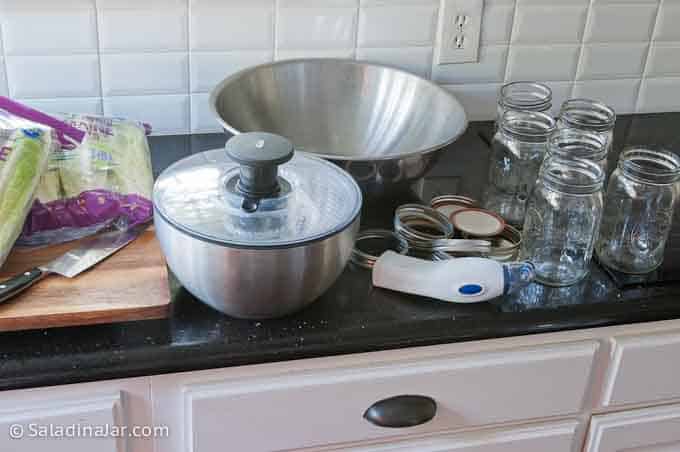
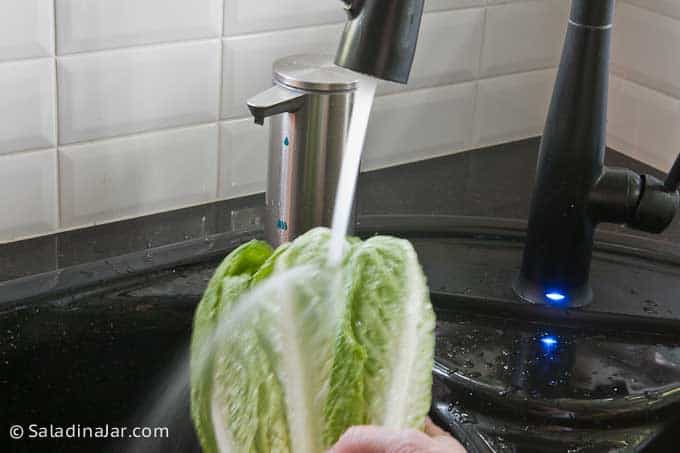
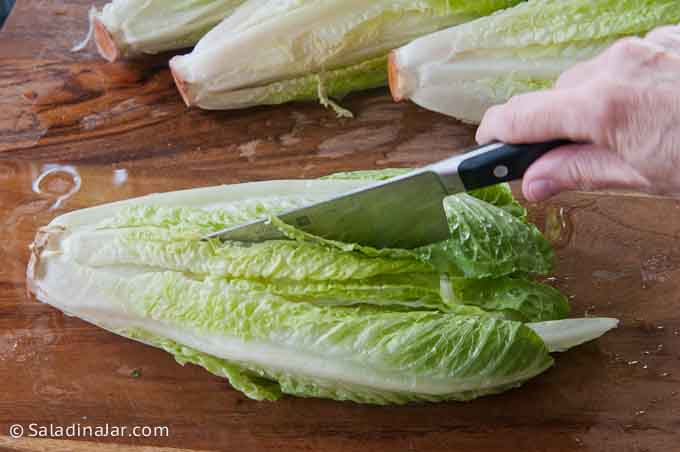
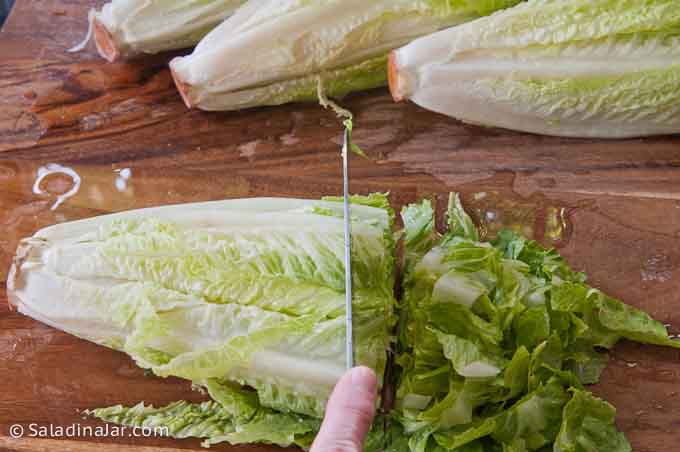
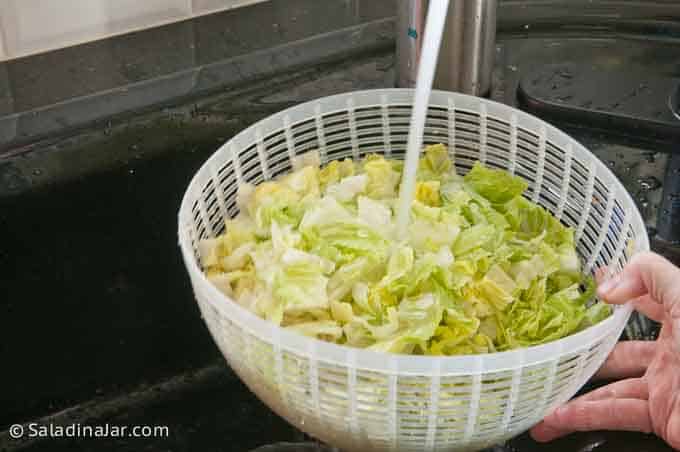
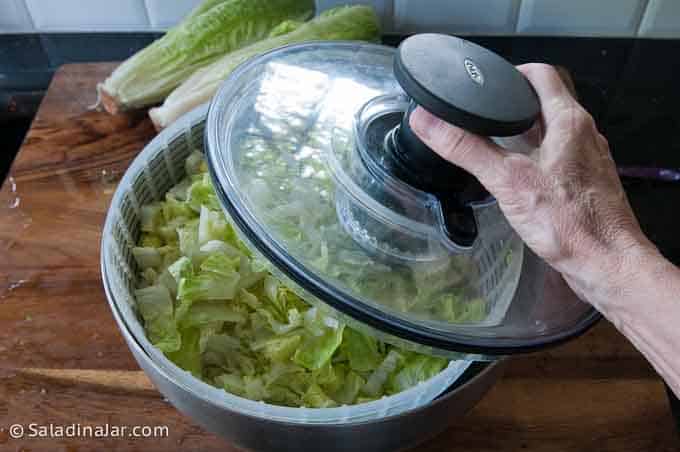
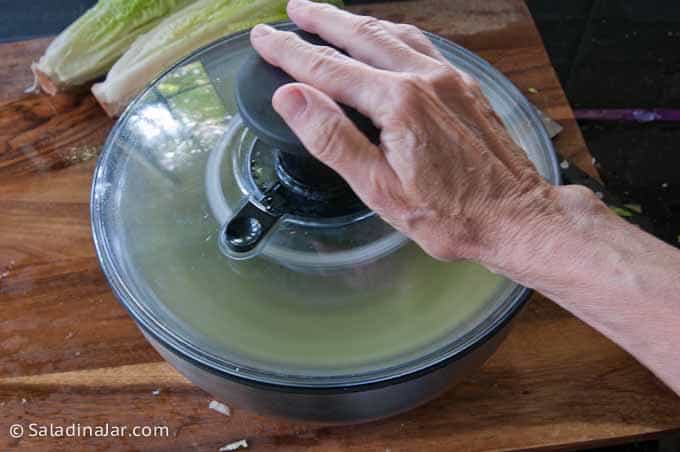
How Do You Vacuum-Seal Lettuce into Mason Jars?
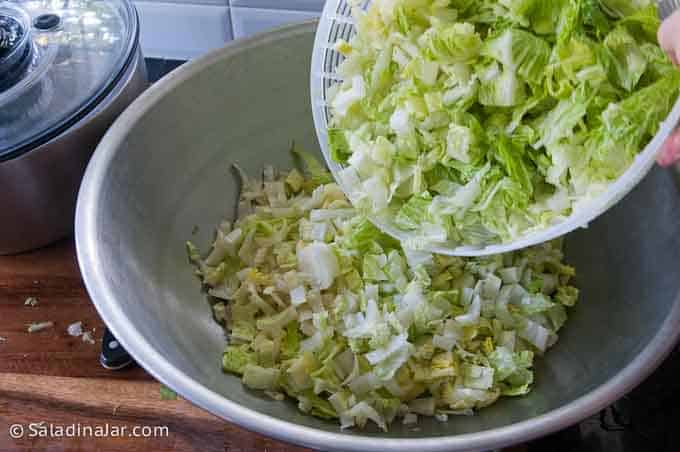
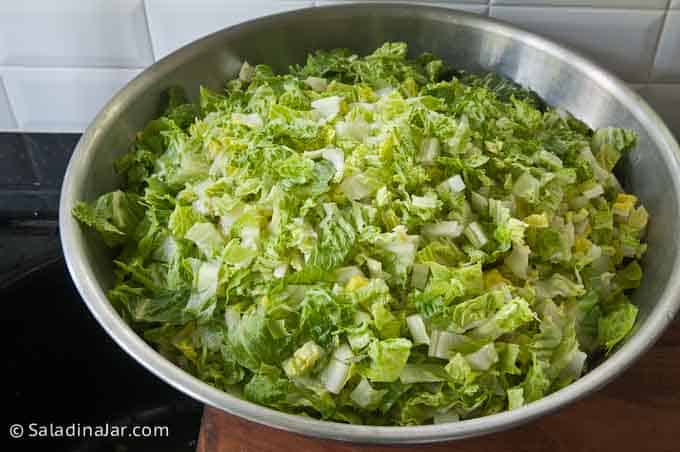
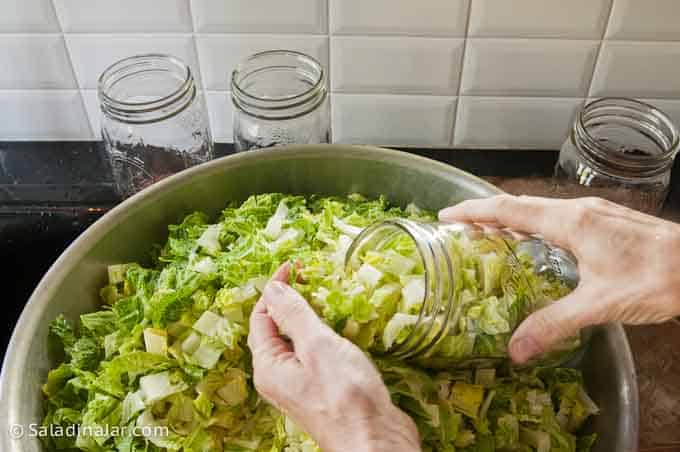
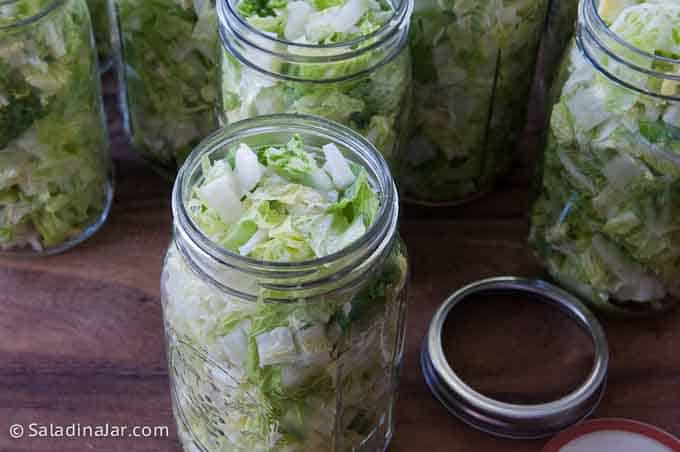
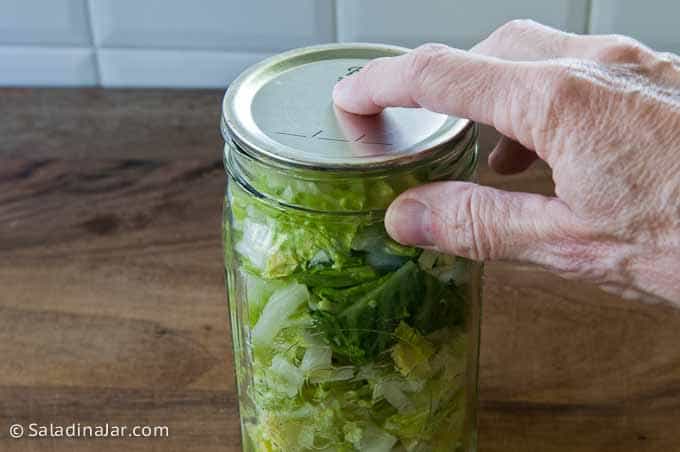
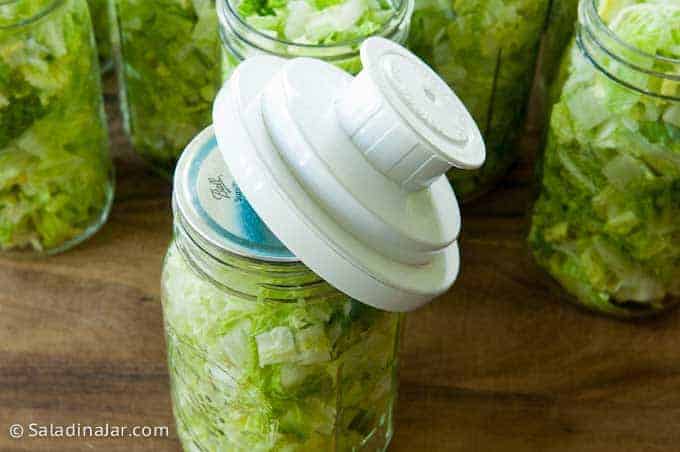
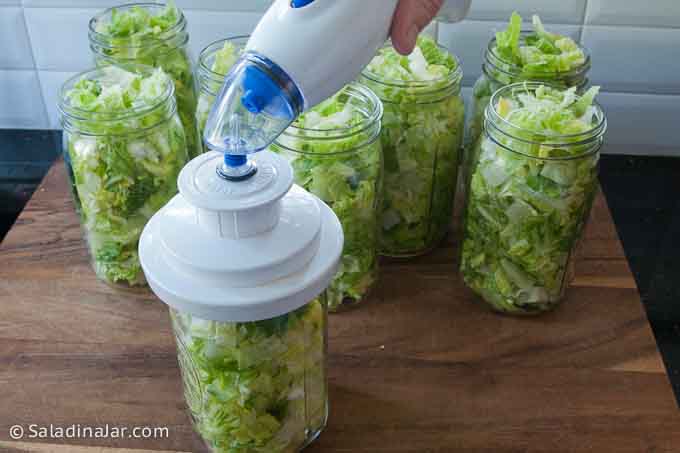
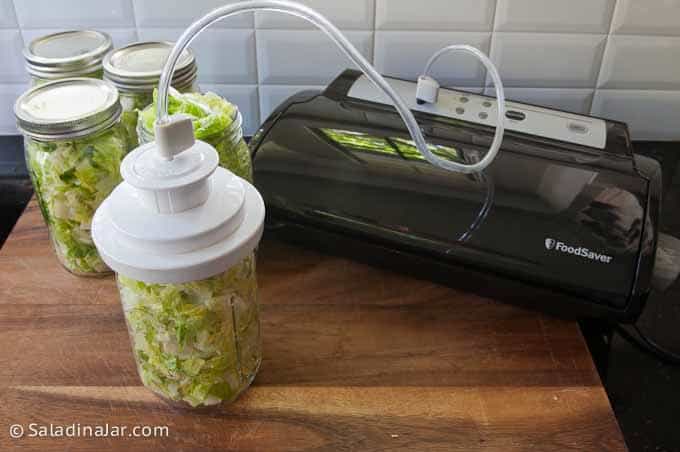
Addendum 6/12/2023: Here’s my favorite portable vacuum pack machine(paid link) to date.
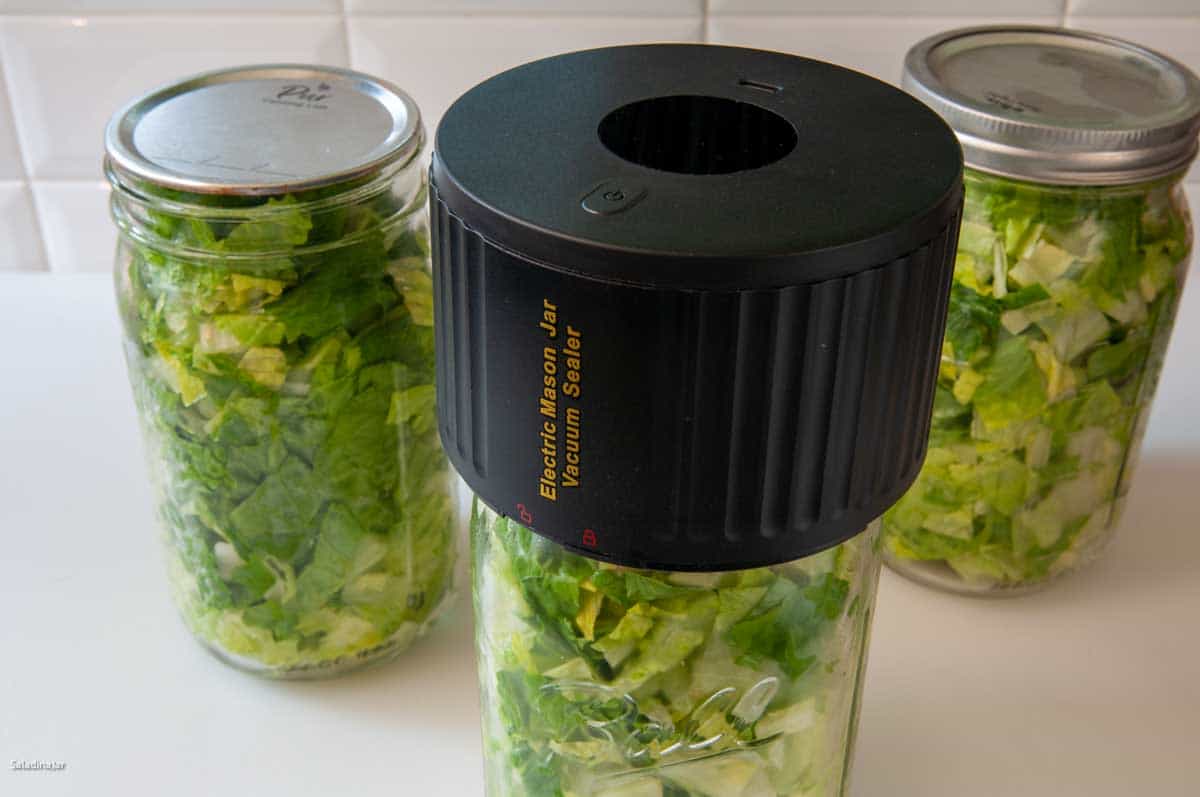
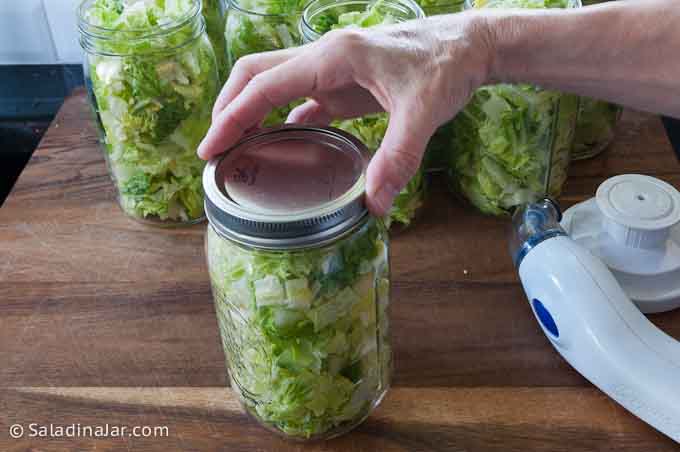
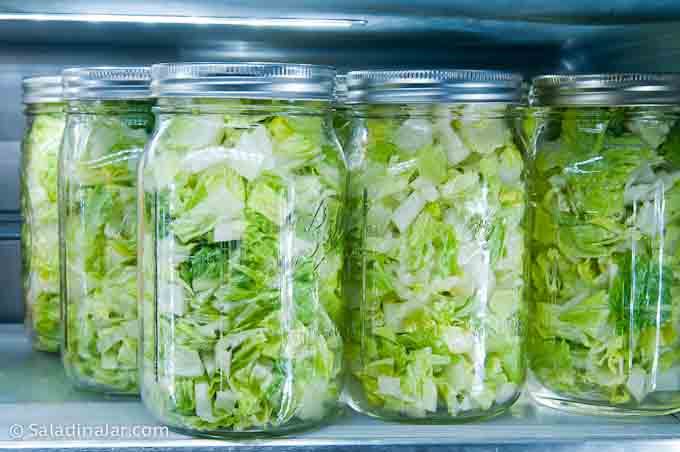
How Do I Open a Vacuum-Sealed Jar of Lettuce?
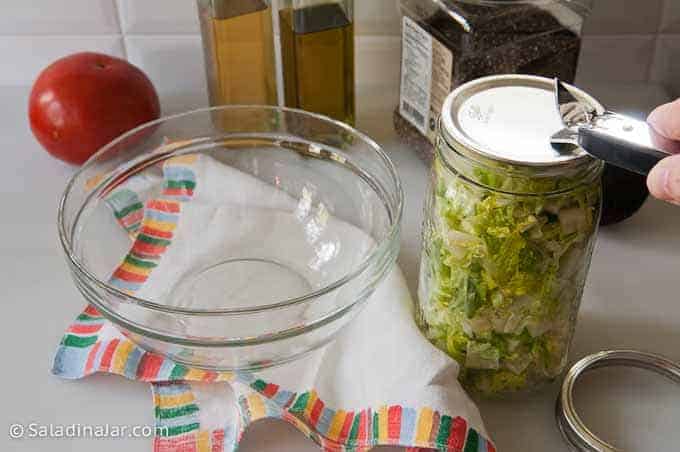
Pry off the lid with a can opener (as pictured above), or use your fingers. Empty your jar of lettuce into a bowl or onto a plate. Add whatever extras you want.
NOTE: I often add other lettuce varieties, such as ready-to-eat spinach, arugula, or spring mix, when I’m ready to eat my salad. Since this lettuce is ready-to-eat straight from the store, it doesn’t add any time. But unfortunately, these types of lettuce are unpredictable when vacuum-packed.
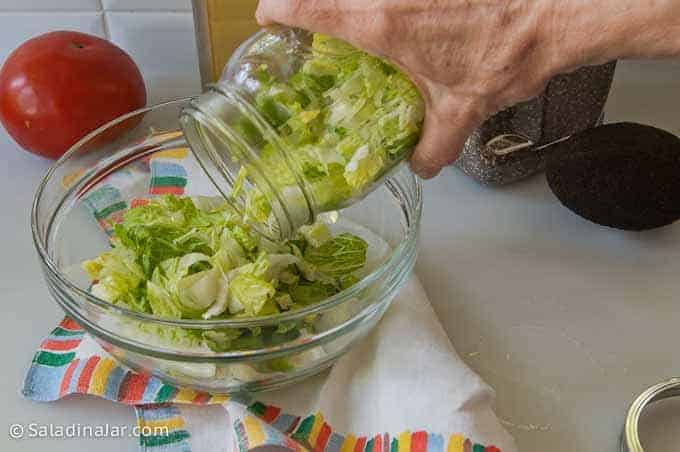
FAQ About Vacuum-Sealing Lettuce in Jars:
Yes. But it needs to be sturdy lettuce like romaine or radicchio. Iceberg would be my third choice. Napa cabbage is another fave that stores well.
I’ve experimented with all these, but none lasted more than 3-4 days. They’re too fragile for vacuum-packing. Although some say it works for them, I can’t recommend it. When it comes to vacuum sealing, I’m a hearts-of-Romaine girl.
Even though I love romaine, the dark green outer leaves will not last as long as the crispier inner leaves. If I have a lot of dark leaves, I try to eat those jars first.
You can, but I don’t recommend it. The results are unpredictable and will most likely shorten the time the lettuce will stay fresh. In my experience, sliced carrots and cabbage will vacuum seal pretty well. Avoid adding cucumbers and tomatoes. Beyond that, I suggest you experiment.
One of my readers, Rick, did an experiment adding various veggies to his jars of lettuce. I wrote a post about it if you’re curious.
7-10 days on average. The freshness of the lettuce when packing can make a difference. As noted earlier, if your romaine includes lots of outer dark green leaves, those leaves are more delicate and tend to go south first.
1. Hearts of romaine lettuce (Romaine lettuce works best because the leaves are sturdy. Spinach and spring mix don’t like to be vacuum-packed.)
2. Sharp butcher knife (My favorite is a Wusthoff Santoku(paid link) knife.)
3. Large chopping board–wood or plastic (paid link)
4. Salad spinner (paid link) (the plastic ones work, but the stainless spinner from OXO is better if you are a heavy user)
5. Large mixing bowl (paid link)
6. Wide-mouth jar attachment(paid link)
7. Quart-size Mason glass jars with 2-part metal lids (paid link)
8. Full-size vacuum-pack machine (paid link)or a portable (paid link) vacuum device (much cheaper and easier to store)
Note: Everything but the lettuce is reusable!
The actual time to prepare 6-8 jars is 30-45 minutes after you’ve had some practice. Expect to spend a couple of hours the first time or two. Once you get your system down, making the jars goes fast.
After a reader suggested this, I did a side-by-side experiment. I rinsed the lettuce with diluted lemon juice and compared it to vacuum-packed lettuce. The lemon juice-rinsed and cut lettuce began to turn brown after three days. No comparison!
Use your quart jars to vacuum-pack rice, flour, oatmeal, granola, and other dry pantry items. Store vacuum-packed stir-fry sauce, barbecue sauce, or salad dressing in the fridge.
Use plastic vacuum-seal bags for cheese, leftovers, and meat. Food stays in the freezer much longer without freezer burn when vacuum-sealed.
Vacuum-packing removes the oxygen that causes the lettuce to brown when there are cut edges–torn or otherwise. I use a sharp knife to chop it quickly and in small pieces. Hands and plastic knives are way too slow for me.
Yes, but the wide-mouth jars are much easier to fill, empty, seal, and wash. Therefore, I highly recommend the wide-mouth over the small-mouth jars.
No. You only need one jar attachment. The attachment fits over the opening with a flat lid between the top of the jar and the attachment. Pull the attachment off after sealing. See the video.
Large-mouth jar attachments are available online. I’ve never seen them in a brick-and-mortar store, but readers have reported sightings.
Be sure you buy the large-mouth jar attachment if you have large-mouth jars. Otherwise, buy the small-mouth attachment.
Yes. You can reuse both. The lids should only be used once when using heat, such as pressure canning. However, vacuum sealing involves no heat. Unfortunately, the lids and collars are prone to rust if not completely dried after washing. But they are easy and inexpensive to replace when necessary.
Check to see if a stray piece of lettuce on the top of the jar is preventing a seal.
Try using two stacked lids instead of one.
Apply some pressure to the adapter holding the lids.
Read this post about 10 tips for getting lids to seal on a Mason jar.
A plastic bag is an excellent way to store washed lettuce if you leave the lettuce whole and un-chopped or un-torn. It will definitely last longer than buying a bag of salad mix from the store. However, the romaine must be cut or torn into smaller pieces before eating.
For me, that’s too much trouble when I walk in the door hungry. I like to have everything ready to grab and go, with leaves already in small pieces and prepared to pour into a bowl and eat. If you’re not as impatient as I am, a plastic bag and some paper towels may be sufficient.
Stuffing a jar with chopped lettuce and screwing the lid on is convenient. However, it won’t keep your lettuce fresh any longer than dumping it in a plastic bag like it’s sold at the grocery store. The oxygen must be removed to keep the chopped edges from wilting and browning.
You can only use a plastic bag if your vacuum-pack machine has a pulse feature that lets you leave some air in the bag. Another option is to stop short of vacuuming all the air out before the lettuce is crushed.
The lettuce won’t stay fresh as long as it does in a jar where all the air can be sucked out without smashing the lettuce.
My preference is a portable device that runs on batteries. They are less noisy, take less storage space, and cost less. Or buy one that is rechargeable (paid link).
If you want a countertop device, look for a machine with a port for the attachment. You don’t need all the bells and whistles for this project, but cheap machines may not have a port. So, beware.
Check Ross, eBay, warehouse stores, Walmart, Target, and online. Or ask around. Many people have a vacuum-sealing machine sitting in their cabinets. Some quit using them after they run out of the bags that come with the device.
Portable units are much cheaper, and they work great.
Some of the leaves may become translucent and limp. If the lettuce doesn’t smell right, throw it out.
Enjoy the virtuous feeling that comes with eating healthy vegetables!
An Important Safety Reminder
Wash your lettuce thoroughly and keep it refrigerated at all times for safety’s sake.
Closing Thoughts: As of December 2022, I’ve been vacuum-sealing jars of chopped lettuce weekly for 17 years. It’s about as much fun as folding clothes and putting them away. However, just as clean clothes neatly stashed in a drawer make life better, so does a refrigerator full of sealed jars of lettuce. I hope this cool trick works for you, too.
Help at Your Fingertips: For questions or suggestions, email Paula at saladinajar.com. If you need help, I’m happy to troubleshoot via email (faster than leaving a comment). Attach pictures and as many details as possible for the best advice.

How To Vacuum-Seal Cut Romaine Lettuce
Rate this recipe
(5 stars if you loved it)
Video
Ingredients
- 6 hearts of romaine lettuce
- 1 small head of radicchio optional
Instructions
- Wash romaine lettuce well, leaving the leaves intact at the base.
- Cut lengthwise through the entire head at least 4-5 times.
- Now slice crosswise about 3/4 to 1 inch apart according to your preference.
- Fill salad spinner and run under the faucet one more time. Spin dry.
- Dump into a very large bowl. Fill jars with chopped, spun-dry lettuce. I pack them as tightly as possible.
- Seal jars using a wide-mouth jar attachment and a vacuum-pack machine. Screw on rings as insurance to keep lid sealed.
- Refrigerate up to 10 days depending on how fresh your lettuce is when you started this process.
Notes
Equipment
Nutrition
All images and text ©️ Paula Rhodes for Salad in a Jar.com

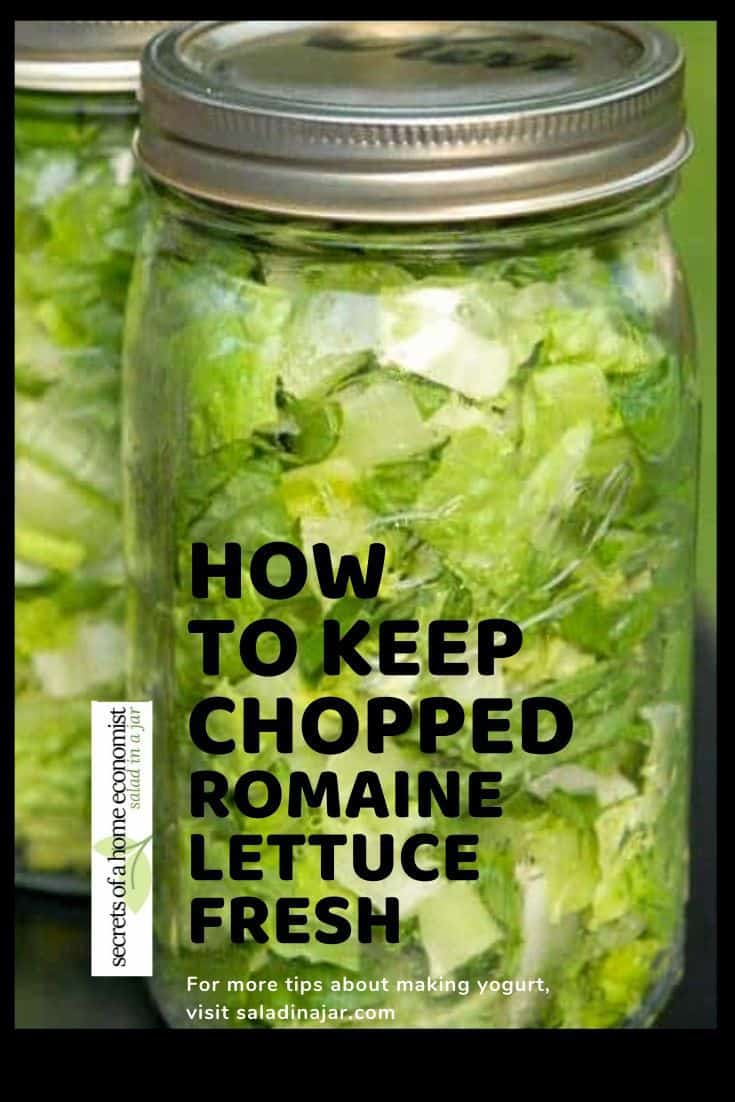

Paula Rhodes, owner
As a retired home economist, I created Saladinajar.com to share my belief that you don’t have to be a chef to find joy in creating homemade food worth sharing. Bread machines (used in an unconventional way), homemade yogurt, and quick microwave recipes are my specialty.